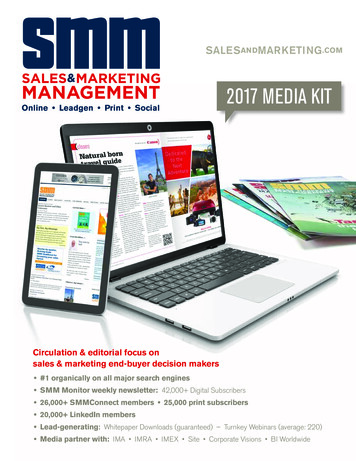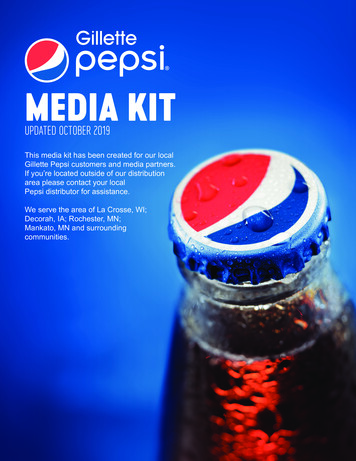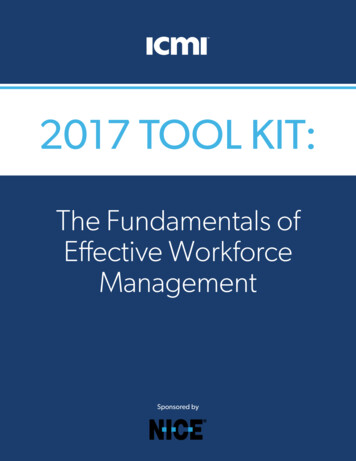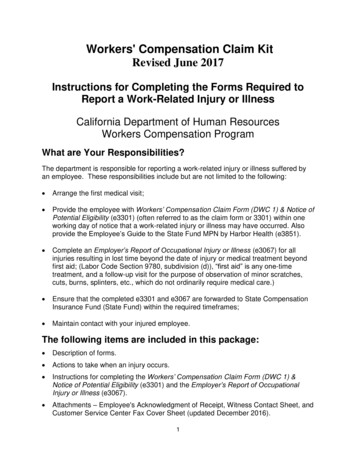
Transcription
SALESANDMARKETING.COMOnline Leadgen Print Social2017 MEDIA KITCirculation & editorial focus onsales & marketing end-buyer decision makers #1 organically on all major search engines SMM Monitor weekly newsletter: 42,000 Digital Subscribers 26,000 SMMConnect members 25,000 print subscribers 20,000 LinkedIn members Lead-generating: Whitepaper Downloads (guaranteed) – Turnkey Webinars (average: 220) Media partner with: IMA IMRA IMEX Site Corporate Visions BI Worldwide
2017Sales & Marketing Management is the premierdigital and print media source for reaching salesand marketing decision-makers. Number one onall major search engines, salesandmarketing.com is where these top sales and marketingprofessionals find essential online resources andinformation. Leverage our reach to tap into theexceptional buying power of this key audience.Our audienceSales & MarketingManagementreaders on average hold3.4off-site meetingsa year involving travel,with averagestays of2.4155nightsand averageattendance ofBuying PowerFast facts about the responsibilities and authority of our audiencesUse merchandise or gift cards for sales incentive/recognition programs87%Plan/manage sales incentive/recognition programs71%Use recognition/service awards71%Decide/recommend business gifts67%Make sales meetings destinations/facilities decisions62%Make sales training decisions57%Purchase sales enablement tools/CRM51%Purchase marketing software/services50%Make their company’s sales travel decisions47%0%20%40%60%80%100%* Sources: SMM Reader Surveys 2016 and publisher’s own data, June/August 2016SALESANDMARKETING.COM20172
2017Our audiencePrimary Business/Industry of SubscribersOther 6%Incentive Company 4%Manufacturing,Wholesaleor Retail58%meetingsAnybody out there?Virtual meetings are a breeding ground for multitasking and inattentionTechnology allowing businesses to hold virtual meetings withemployees who are scattered across the country or even globallyprovides enormous benefits, including substantial savings inboth travel time and cost. But there are downsides to meetingvirtually, not the least of which is the struggle to hold attendees’attention.The challenge of keeping virtual meeting participants frommultitasking presents leaders with a two-pronged question asthey plan their 2016 meeting strategies: Is the meeting agendaimportant enough to bring the group together offsite, or is it solight on critical information that a virtual meeting isn’t evennecessary?“If people are multitasking on your calls, first ask yourself ifthey are right — is Facebook or the latest email or text actuallymore interesting and relevant than your meeting? If it is thenyou can’t really blame people for multitasking — much as wewould like to,” says Kevan Hall, author of “Speed Lead: Faster,Simpler Ways to Manage People, Projects and Teams inComplex Companies.”ServiceOrganization 32%Llamas gotta’ eatThe problem was highlighted in a recent New York Times articlein which a half-dozen or more virtual workers confessed totackling everything from cleaning house to doing yoga duringAnnual Sales VolumeNot Specified16%A half-dozenor more virtualworkers confessedto tacklingeverything fromcleaning house todoing yoga duringconference calls.Over 1 Billion10% 50 Million to 999 Million4% 10 Millionto 49 Million11%conference calls. John Halamka, a chief information officer fora Boston hospital, said he spends approximately six hours aweek on conference calls from his Sherborn, Mass., farm, andhe uses the time to sand and varnish office furniture, walk hisdogs or tend to his llamas — restocking the hay feeders, fillingwater buckets and shoveling manure.A San Francisco marketing consultant who spoke to theTimes for the same article admitted to falling asleep during onecall with London-based client and she was awakened by herown snoring. (In her defense, the time difference meant she wason the call in the middle of the night.)Some companies are shifting to videoconferencing in attemptto resolve the wandering ways of their meeting attendees, butparticipants often opt out of the video component claimingtheir service is not strong enough.If a manager senses attendees are checking out mentally froma virtual meeting, something should be said, advises Hall. “Onceyou have done what you can to make your calls engaging, then itis time to call out others who are multitasking. It may be thatthey don’t need to be at your meeting, but if they do, then theyreally need to be present throughout. If it’s important, it needsour full attention; if it is not important, then we shouldn’t behaving a meeting to discuss it.”20JAN/FEB 2016SALESANDMARKETING.COMcover story 50 Millionto 499 Million59%Job TitleCorporateManagement12%How do I keep remoteTOUGHQUESTIONS employees engaged?Corporate cube farms continue to giveway to remote workers who may workthree miles away from their manageror three time zones away. Thecapability to work remotely for acompany allows managers to hold onto some top performers who mayotherwise leave a company forgeographical reasons.The upside is continuity and theability to hold on to high-flyers’industry and company knowledge.The downside is the challenge ofkeeping remote workers engaged,and feeling and working like a team.“Working from home, whilstconvenient and desirable, is also asystem that relies heavily on anemployee’s motivation,” says DaveNevogt, founder of Hubstaff, an appthat allows employers to track theiremployees’ time and productivityvia screenshots. “It is up to employersto provide motivation across many miles,sometimes continents.”These tips for keeping remote workersmotivated and feeling connected to the team arefrom blog posts, interviews and articles.Other 15%Make them feel valued – “Not being in theoffice is not the same as being unimportant,” saysKonrad Waliszewski in a blog post at Speek,providers of a platform for online meetings.Keep remote workers engaged by asking for theiropinions on different issues. Include them ininteroffice changes. Never let remote employeesfeel disenfranchised or isolated because of wherethey work. “Most employees will respondfavorably when they know you consider them animportant part of the team,” Waliszewski says.Sales andMarketingManagement73%Recognize regularly – “The biggest risks forremote workers are feelings of isolation, beingundervalued and out of touch. Recognitionovercomes all three,” says Jonathan McClellan,director of employee recognition at HallmarkBusiness Connections, the B2B subsidiary of34MAY/JUNE 2016Hallmark Cards. The company provides aplatform for delivering customized eCards andreward certificates electronically. “It validates thequestions we all have: ‘Am I focused on the rightthings?’ It creates human moments in whatotherwise can be chaotic corporate days,”McClellan says.Don’t neglect career development – Fosteringemployees’ careers is one of the most appreciatedrewards you can give. Just like the people in youroffice, remote workers have goals and aspirations.Ensuring they make progress on their goals forgrowth and understand the career paths availableavoids confusion or frustration, states theLighthouse blog on management and leadership(getlighthouse.com/blog). “Long-term motivationcomes from loyal, committed team members —and we create loyal, committed team members byinvesting,” adds business consultant Susan Drum(SusanDrumm.com).Provide feedback and ask for it in return –Your team wants to know what is working andwhat could be better. Be candid in NG.COM20173
2017REGULAR READSThese sections appear in every issueof Sales & Marketing Management: Next – Quick reads on sales and marketingtrends, talkers and what lies ahead Incentive Product Review – A closer lookat the most popular categories of non‑cashincentives Closers – Insightful Q&A interviews withsome of the most notable figures in business Meetings and Incentive Travel – Drivingperformance with incentive travel experiencesand effective use of offsites. Our coverageincludes the latest research from the IncentiveFederation, the SITE Foundation and otherincentive travel associations and organizations. Technology – Stay current on the high-techtools and tactics that leading companies areusing to build brand and increase sales.ISSUECOVER FEATUREJANUARY/FEBRUARYBeyond EngagementAd Close: 12-2-16Materials: 12-7-16Mail Date: 1-10-17Editorial calendarTrainingSales ManagementIncentives & RecognitionMarketing TechnologyMeetingsmarketing opinionHot lessons fromhotel lobbiesConsider the concierge approach to personalized sales and marketingHave you ever spent time browsing the racks of promotionalpamphlets that litter the lobbies of lower-priced hotels? Everypossible option is arrayed before you, but unless you’reespecially committed to the search, it’s hard to justify scanningthem all just to find one option you’d care to consider.Stay in a slightly better hotel, and these same brochures areconcealed behind a desk where a clerk can grab those thatanswer your general request. This is only a marginalimprovement, since you’re still expected to glean the answerfrom the same generic brochures.Ah, but if you’ve ever stayed at an exceptionally nice hotel,you may have been lucky enough to encounter a knowledgeableconcierge who, after asking a few insightful questions aboutyour goals for sight-seeing, dining or shopping, makes arecommendation perfectly tailored to your needs.Sales and marketing professionals who want to personalizeinteractions with each of their buyer personas would do well tohang around this concierge desk for an hour or two. Watch forguests’ reactions when this expert asks a few simple questionsabout their expectations and responds with a simple andconcise recommendation. Notice the way the conciergecommunicates only the facts related to a particular question,concern or priority expressed by each guest.Then consider the power this hotel has over guests’ buyingdecisions by eliminating their perceived risk of making thewrong choice. A helpful concierge offers a number of usefullessons about earning the buyer’s trust and speeding them ontheir way to a buying decision.Traditional market segmentation is dead; long live the buyerpersona. The hotel doesn’t assume that guests of a certain age,gender or other demographic attribute will all want to visit thesame restaurant or attend the same events. Instead, theFRESH VOICES & UNIQUE INSIGHTSEach issue features insightful columns fromsome of the most experienced andinnovative thinkers in B2B sales andmarketing. Tim Riesterer on The SalesConversation – The chief strategy andmarketing officer at Corporate Visionsshares insights on telling the right storiesin a compelling manner.A helpful concierge offers a numberof useful lessons about earning thebuyer’s trust and speeding them ontheir way to a buying decision.14MAY/JUNE 2016concierge’s responses are basedon just a few questions about theguest’s desired outcomes,concerns and decision criteria.These facts are precisely whatBY ADELE REVELLAthe hotel needs to respond witha message that resonates with the guests and inspires them totake action.This is why companies need insight into their target market’smindset about the buying decision they want to influence, andwhy it is not helpful to simply profile buyers based on whothey are.Too much content causes confusion, and confused peopledon’t buy anything. As seen in the hotels stocked withpamphlets about every possible attraction, when people arepresented with too many choices, the need to consider all ofthem introduces risk and friction into the sales cycle.Companies need to ensure that only a few of the mostdesirable options are presented to the buyer, which has thesurprising added benefit of reducing the amount of content andsales tools their teams need to build and manage.Insight into your buyer’s expectations is a powerfulcompetitive advantage. Even if you don’t work for a restaurantor theme park, I’m sure you can imagine the challenge ofproducing a pamphlet that would stand out on those lobbyracks. This isn’t all that different from trying to produce themost beautiful website or the most persuasive messaging foryour website, demand generation programs and sales plays.But when you have insight into to your buyer’s specificexpectations, you know how to respond with messages yourbuyers want to hear, immediately distinguishing yourself fromthe pack (or the rack of brochures).At every step in your buyer’s journey, they look for answersthat will clear up their confusion and guide them to a low risk,effective solution. If your sales pitch or marketing campaignsare targeted to your buyer’s job title, company size or industry,consider the alternative: thinking like a concierge might be thebest way to earn your buyer’s trust.Adele Revella is CEO of Buyer Persona Institute (buypersona.com)and the author of “Buyer Personas” (Wiley 2015), which was named atop-five business book of the year by Fortune magazine. Follow her onTwitter @buyerpersona.SALESANDMARKETING.COM Marketing Voices – This column rotates among top B2Bmarketing professionals who answer the questions that are topof mind for today’s marketing executives — or should be.Whether talking about customers oremployees, it’s time to get past thebuzzword and build real business valueMEETINGS &INCENTIVE TRAVEL Creative networkingideas for offsitesINCENTIVEPRODUCTREVIEWGift cardsBONUSDISTRIBUTIONTraining 2017Conference & ExpoJan. 30-Feb. 1, 2017San DiegoALSO IN THIS ISSUE: Incentive Manufacturers & RepresentativesAlliance (IMRA) DirectoryMARCH/APRILWho Controls the Sales Journey?Ad Close: 2-6-17Materials: 2-8-17Mail Date: 3-14-17 Don’t resent self-educated buyers,embrace them Customer insights are hiding inplain sight Flying solo: why andwhen individualincentive travel makessenseLifestyle/travel/experientialThe Association forTalent Development(ATD) InternationalConference & ExpoMay 21-24 The allure ofsecond-tier citiesfor meetingsLuxury anddesignerbrandsSociety forHuman ResourceManagement (SHRM)Conference & ExpoJune 18-21 Buyer’s journey myths debunkedMAY/JUNEKicking Out the CompetitionAd Close: 4-10-17Materials: 4-13-17Mail Date: 5-16-17True stories of taking business awayfrom competitorsSALESANDMARKETING.COM20174
2017Sales & Marketing Management is the best lookingpublication in the market, with a unique blend ofeditorial content that engages sales and marketingmanagement, while providing rich editorial on theproven benefits of non-cash incentives. It reaches thedecision makers with my message.”Editorial calendarMAYJUNE2016EDITED BY PAUL NOLAN6 reasons not to bash thecompetitionThe sales environment is competitive, often looking, feeling andsounding like the world of sports. In sports, before meeting atough opponent, coaches warn their players to refrain fromspeaking negatively about the opponent for fear it will motivatethe other team’s players.In B2B sales, taking an aggressive stance toward thecompetition when talking to customers and prospects istempting, but ill advised, says Pat Morrissey, a senior accountexecutive at ConnectLeader, a provider of sales accelerationsolutions. “Many of us have encountered the slick-soundingsalesperson who can rattle off a list of reasons why the customercan avoid doom and destruction by staying away from ourcompetitors. While this may look and sound impressive, I haverarely seen it work out well for my colleagues, or for me,” hesays. He offers these six reasons for not bashing the competition.2. It lowers the bar for the competition.All the competition has to do is prove you wrong on one fact andthey have proved you to be liar. At the very least, the customer isfar less likely to give you any credibility, even on matters thathave nothing to do with the competition. However, you owe it tothe customer to share information about the competition ifasked. Make sure you preface it correctly though. Best to let thecustomer know that you have been told something (by anothercustomer or prospect) than to present it as a fact in and of itself.This way they will know you weren’t lying or exaggerating if itturns out to be untrue or out of date information.3. It invites the customer to check back withthe competition.6JULY/AUGUSTThe Technology IssueGetting SocialAd Close: 6-1-17Materials: 6-6-17Mail Date: 7-11-17We all know the old saying: “When you point afinger at someone, three are pointing back at you.”The customer will expect you to prove thatanything you say about the competition is not truefor your company as well. This can extend thesales cycle, and time kills all deals. In extremecases, you can convince the customer that therisks are too great and that they should reconsiderthe project altogether. I’m sure many of us haveheard something like this: “Thank you so muchfor the information. We are going to hold off ondoing anything for now thanks to the greatinformation you gave us.”They may like the competition or may havealready done business with them. At the very least,they thought well enough of the competition tolook at them along with you. By bashing thecompetition, you are at the very least telling yourcustomers that they are uninformed. At its worst,you are telling them that they are stupid. It isbetter instead to praise the customer for making agood decision regarding the competition. This willmost likely facilitate a conversation about whatthey liked about them and what you need to showor do to get their business this time.1. It’s a waste of time.By focusing on your customer, you can steal their attention fromyour competition, whom they may never check back with. If youbash the competition, the customer will at least check back withthem to validate what you told them. Now the competition is inCOVER FEATUREBetter than bashing6. It insults the customer.Your customer’s time is limited and you have a small window oftime when you can get their attention. The best way toaccomplish this is by focusing on the customer’s needs and howyou can help. You will lose this focus and the customer’sattention if you concentrate on what’s wrong with thecompetition instead of the customer’s business needs.Mike Landry, Director, Special Markets, TUMIISSUEWhat you’ll be talking about.5. It conditions the customer to bewary of the marketplace. Facebook is the 800-pound gorilla,but where else do B2B brandsneed to be?MAY/JUNE 2016the batter’s box and you aren’t. This can work in your favorthough, when the competition bashes you. (See item #2.)4. The customer usually knows more about thecompetition than you do.Use any conversations about competition as an opportunity tolearn from the customer. They will often have first-handinformation that they will usually share with you if you arewilling to listen. Better to learn what your own company needsto do to be more competitive than to use guesswork and secondhand information to try to sway the opinion of your prospect.SALESANDMARKETING.COM“By bashing thecompetition, you are atthe very least telling yourcustomers that they areuninformed. At its worst,you are telling themthey are stupid.”Bashing the competition irritates the hell out of customers. It showsinsecurity, weakness and is poor business practice, says James Purvis,a regional sales manager at Okta, a provider of software as a solution(SaaS) business tools. “It’s not your job to speak negatively aboutyour competition. It’s your job to solve the customer’s problems andadd value to their business.” Purvis recommends three alternatives tospeaking negatively about competitors:Steer prospects back to valueWhen a prospect asks, “How do you compare to XYZ company?” mostsalespeople respond immediately with something negative. Don’t be likeeveryone else. Point out something they do well (but you do better) andsteer the conversation back towards how you will tackle their businessproblem and add more value.Bring up the competition earlyThere is a competitor in every deal.
or Retail 58% Job Title Sales and Marketing Management 73% Corporate Management 12% Other 15% 10 Million . rewards you can give. Just like the people in your office, remote workers have goals and aspirations. . (ATD) International Conference & Exp











